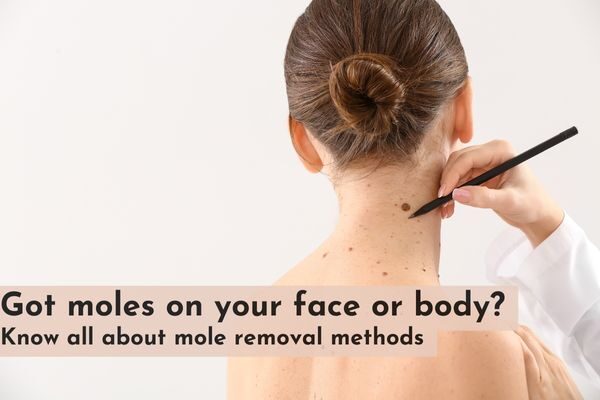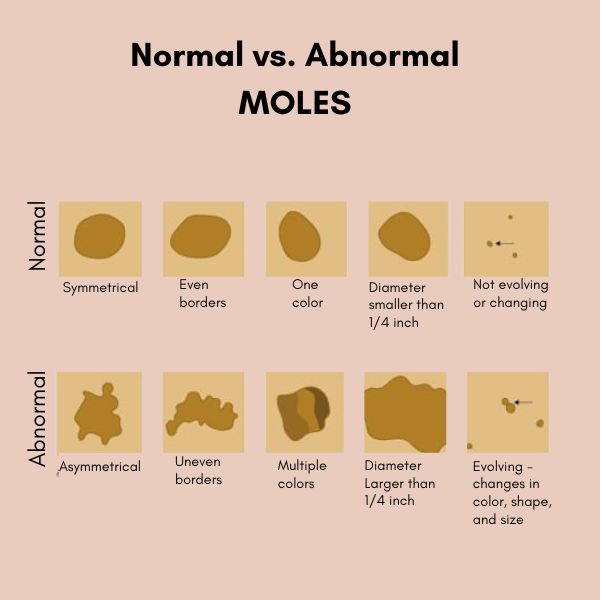
Moles occur when cells in the skin grow in a cluster instead of being spread throughout the skin. These cells are called melanocytes, and they make the pigment that gives skin its natural colour. Moles may darken after exposure to the sun, during the teen years, and during pregnancy.
However, most of the moles are benign which means they are not cancerous, some can develop into melanoma, a serious type of skin cancer. If a mole starts to itch, bleed, or become painful, it is important to have it checked by a dermatologist and keep a constant watch on its shape, size, and texture of it. In this guide, we will provide you with everything you need to know about mole removal treatment.

Types of Moles
Before considering mole removal treatment in South Delhi, it is important to know the different types of moles and their characteristics. The three main types of moles are:
- Congenital moles: These are moles that are present at birth or appear within the first year of life. They are usually larger than common moles and have a higher risk of developing melanoma, a type of skin cancer.
- Acquired moles: These are moles that appear after birth and are the most common type of mole. They can be flat or raised, smooth or rough, and range in colour from tan to dark brown.
- Atypical moles: These are moles that have irregular or asymmetric borders, varied colours, and a larger size than common moles. They have a higher risk of developing melanoma.
Causes of Moles
Moles are caused by clusters of melanocytes, cells that produce the pigment melanin, which gives colour to the skin, hair, and eyes. According to SkinQure, the exact cause of moles is unknown, but they may be influenced by genetic and environmental factors, such as sun exposure.
When to Consider Mole Removal?
Moles that are changing in size, shape, colour, or texture should be evaluated by a dermatologist to rule out skin cancer. Other reasons for mole removal include:
- Cosmetic: Moles that are large, prominent, or located in visible areas of the face or body may cause self-consciousness or affect self-esteem.
- Irritation: Moles that are constantly rubbed by clothing or jewellery may become inflamed or bleed.
- Suspicion: Moles that are irregular or atypical may be biopsied or removed to prevent the development of melanoma.
Mole Removal Treatment Options
Mole removal treatment options depend on the type, size, location, and characteristics of the mole, as well as the patient’s preferences and medical history. The most common mole removal treatment options are:
- Excision: This involves cutting out the mole with a scalpel and suturing the wound. It is typically used for larger, raised, or atypical moles that may be cancerous.
- Shave removal: This involves using a blade or laser to shave off the mole at the surface of the skin. It is typically used for smaller, flat, or benign moles that are not suspected of skin cancer.
- Laser removal: This involves using a focused beam of light to break down the pigment cells in the mole. It is typically used for smaller, flat, or pigmented moles that are not cancerous.
Mole Removal Procedure
Mole removal procedures are typically performed in a dermatologist’s office under local anaesthesia. The procedure may take 10-30 minutes depending on the size and location of the mole. After the mole is removed, the wound is cleaned and dressed with a sterile bandage. The patient may experience some pain, swelling, or redness at the site of the removal, which can be managed with over-the-counter pain relievers and cold compresses. The patient should avoid sun exposure and excessive sweating until the wound has healed completely.
Risks and Complications of Mole Removal
Mole removal is a simple process like any other medical procedure, however, it may involve some basic risks and complications like minimal swelling and bleeding. Although the chances of having these risks is inversely proportional to the qualification of a doctor. In this regard, you can also reach out to dermatologist in South Delhi. Visit https://skinqure.in/gallery/mole-removal/mole-removal-results to see our Mole removal treatment results.
